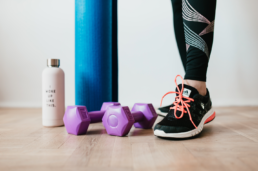Making Home Workouts More Enjoyable and Successful
By Sandra Huskey, First Mile Care, DPP Coach
A few weeks into the new year is the danger point for resolutions involving fitness. The glow of the holidays has passed and you’re back into your daily grind. Depending on where you live, you may be stuck indoors much of the time due to winter weather and/or restrictions around the ongoing pandemic. It’s easy to slip into the bad old habits.
When it comes to setting fitness goals, you need to be realistic. Focus on one or two small goals and work toward those so you are rewarded with success — and then set new goals! Other factors affecting success include finding appropriate exercises. “Appropriate” means not only exercises that work toward your goals, but that are modified to your current level of fitness. Keep it fresh by varying your workout routine every 6 to 8 weeks as you increase your level of fitness.
Help yourself to meet your fitness goals by setting aside regular time for them. Our lives revolve around schedules. We have schedules for work and for when we eat, when we meet friends for coffee, or drive our kids to events. Even if we’re working or attending classes from home, we’re still keeping to schedules for our Zoom book clubs and parent-teacher conferences. As a result, it’s easy to skip exercising as you’re just “too busy.” To make your in-home workout part of your routine, be sure to add it to your calendar so it becomes a priority. By making fitness a regular part of your scheduled activities, you will be more inclined to stick with it.
Plan on it!
Your workout can be the best part of your day if it’s something you’re prepared for. Know what you’re going to do by creating a workout or activity plan. Make sure to have any equipment you will be using all set and ready to easily grab to avoid looking for your equipment in the middle of your routine. Decide what your very first movement will be. Will it be breathing exercises, overhead arm stretches, or a brisk walk? By setting your plan into motion, you will be mentally prepared to move into your activity or exercise routine. Make sure to schedule this time for yourself, whether it means getting up early or sandwiching it into your workday. Visualize yourself getting dressed and ready, feeling energized and relaxed and listening to your favorite music. So once your shoes are on, your feet will be actively telling your brain that it’s “Go Time!”
Make it competitive
If you’re goal oriented or competitive, working out at home can still be a competition! Whether you’re competing against yourself or a virtual workout partner, you can create opportunities to win. Making your workouts competitive can be highly effective and enjoyable as you strive to set personal bests. Setting time goals (gradually increasing the timing of your planks or your walks), weight goals (increasing the weight of your dumbbells or resistance bands) or number goals (increasing the amount of repetitions or sets) can keep you motivated as you incrementally make fitness improvements.
Give yourself a reward
The most enjoyable part of competing is winning! When you reach a new fitness or activity goal, reward yourself. Set a realistic, achievable goal and then announce to yourself in advance what the prize will be. A new exercise outfit or even a new pair of colorful sport socks may just be the incentive you’re looking for. Or perhaps you’ve always wanted a massage but you haven’t been able to justify it. Set your goal high enough that the reward is worth the work.
Steady results
You can see visible results from an in-home exercise program using minimal equipment in as little as a few weeks. Within the first month, you should notice improvements in your mood. That’s because when you exert yourself through exercise, your brain produces lots of feel-good chemicals that enhance your feelings of happiness, energy, and confidence while also relieving stress and anxiety. In addition, you may also see improvements in your sleep. You can expect to see small physical changes in as little as three weeks; however, significant muscular changes develop more slowly, typically in six to eight weeks. In six months or longer, you should notice changes in blood pressure and body mass and inflammation.
Setting small goals and scheduling your personal in-home fitness routine will set you on the road to a lifestyle of fitness that benefits not only your physical body, but your mood and sleep as well.
To learn more about how you can benefit from the First Mile Care Diabetes Prevention Program, take the prediabetes risk test and get started today!
Building Blocks for Creating a Healthy Life Balance in the New Year
By Kathy Gregory, First Mile Care, DPP Coach
The new year is traditionally a time for self-reflection. After a difficult year of adjusting to a “new normal,” it’s time for a re-set of ambitions and expectations for the year to come. “Leading a Balanced Life” is a session in the First Mile Care ongoing series of “Diabetes Prevention in Action” webinars that provides guidance for improving your health and your overall life in the new year.
Achieving a healthy balance in life sometimes seems as likely as stumbling across a unicorn. Healthy balance usually means finding a satisfactory degree of success in the areas of your life that contribute to your overall well-being: health, physical activity, home cooking, home environment, relationships and social life, joy, spirituality, creativity, finances, career, education, etc.
If you rate your success in each of these areas, you’ll undoubtedly find some imbalances. It’s important to remember that success in these areas is measured by you and not by comparisons to other people. You get to decide what success feels like for you, which will be different than it is for other people.
Oftentimes, in the areas where you’re struggling, you may not be spending as much time and energy as you need to achieve success. How can you make space for these changes to create a better balance, and do you need help from others to do it?
Six building blocks for a healthier balance
In the area of health, there are six specific building blocks to consider when trying to achieve a better life balance. They are interconnected, so that when you make improvements to one, you’ll tend to see improvements elsewhere. Here are some questions to ask yourself to evaluate your health balance.
- Nutrition: How healthy are your eating habits? How would you rate the quality and the variety of the foods that you eat? How often do you plan your meals, and how healthy is your meal prep?
- Physical activity: Are you active or sedentary throughout your day? How often do you exercise each week, and do you do exercises that you enjoy? What obstacles are getting in your way for exercising? (The First Mile Care DPP program has a goal of 150 minutes of physical activity a week at a minimum.)
- Sleep: What is the quantity and quality of your sleep? Do you have a sleep ritual that signifies when it’s time to wind down? How is your sleep environment? How often do you have a hard time falling back asleep? (Learn more about healthy sleep habits in this First Mile Care webinar.)
- Stress: How would you rate your stress level? How is stress affecting your mental and physical health? What are your current coping mechanisms for managing stress? (If you’re experiencing more stress than a year ago … you’re very normal.)
- Healthy mind and feelings: Do you have a positive attitude or do you struggle with negativity and discouragement? How would you describe your internal self-talk? Do you have some type of gratitude practice?
- Empowerment and planning: Do you plan for success or do you just jump right in and hope for the best? Do you tend to use the resources available to you or go at new opportunities alone?
How success looks to you
A new year has begun. Choose one to three areas in your life in which you would like to see changes this year. Think about how changes in these areas could affect your overall health. Determine what empowerment and planning strategies need to be in place in order for you to succeed.
Creating an action plan is very helpful when it comes to setting goals for yourself in order to create lasting change. It’s also helpful to create definite space in your schedule as too often, if it’s not on your calendar, it may not happen. Sharing your goals with a friend or a family member can also be very beneficial in keeping you accountable towards your goals. Community support is one of the most powerful success motivators of the First Mile Care Diabetes Prevention Program.
Please watch the webinar and work though my “Wheel of Life” self-assessment activity to help you determine how to create better balance in your life. And happy new year!
To learn more about how you can benefit from the First Mile Care Diabetes Prevention Program, take the prediabetes risk test and get started today!
Creating a Healthy Life Balance in the New Year
First Mile Care DPP Coach Kathy Gregory shares tips on achieving a healthy balance. This usually means finding a satisfactory degree of success in the areas of your life that contribute to your overall well-being such as health, physical activity, home cooking, relationships etc. Learn more from Thrive Global >
COVID-19 has made it worse for already struggling private practices
Modern private physician practices continue to face challenges that are often driven by nonmedical issues such as increasing administrative burdens. Read more from Daphne Li, managing director of business acceleration at Health2047 and chief operating officer for First Mile Care, and Michael Tutty, PhD, MHA, group vice president of Professional Satisfaction and Practice Sustainability at the AMA here >
Keeping Fit During the Holidays
First Mile Care DPP Coach Shavon LaBlanc gives her tips for making time for exercise in your busy holiday schedule. Learn more about the mental and physical benefits of exercise at Thrive Global >
Keeping Fit During the Holidays
By Shavon LeBlanc, First Mile Care, DPP Coach
The holidays are usually a time of parties, family outings, and travel. They will look a bit different this year but may still include indulging in rich foods that are significant to your cultural traditions. Shared family time is filled with watching sports or movies on TV, playing video and board games, and lots of fun chatter — often without organized group exercise. With the hustle and bustle of the holidays, it’s easy to let your fitness goals slide.
For many people, the holidays can be stressful. Physical fitness is a source of stress relief and can be essential in maintaining your fitness goals and reducing sedentary activity. Whether your goals are to increase your daily steps, add weights to your workout, change your eating habits, adopt a healthy mindset, or improve your overall health – pressing towards your goals is still do-able at the end of the year despite the holiday distractions.
As a certified fitness instructor, personal trainer, registered pharmacist, and coach in the National Diabetes Prevention Program (DPP), I educate people on how to lower the risk of chronic illness by making incremental lifestyle changes involving physical activity and healthful eating. I recently led a demonstration on “Staying on Track with Fitness During the Holidays” as part of the First Mile Care ongoing series of “Diabetes Prevention in Action” webinars.
The whys and hows of exercise
Exercise improves the overall quality of our lives and is truly the gift that keeps on giving. People benefit from it in different ways and degrees, but here are several of the top benefits:
- Reduced risk of chronic illness. Exercise is a key component in helping your body control its blood sugar level and insulin sensitivity which can lead to a chronic illness like diabetes. (Recent research shows that people with chronic illnesses are at greater risk of severe complications and/or death from COVID-19.)
- Weight control. Exercise helps with controlling weight. You want to try balancing your physical activity with your calorie intake. Nutrition facts labels can be a helpful guide in determining daily calorie intake.
- Mental health improvement. Exercise releases chemicals in the brain that lead to feelings of happiness and a sense of euphoria.
- Stronger bones and muscles. Exercise strengthens muscles and improves bone density. This helps reduce the risk of hip fractures and knee replacement associated with the increased risk of falls that occur as you age.
- Improved longevity and mental acuity. Exercise keeps your brain sharp and can help improve your ability to recall details as you age.
Consistency is key in reaching any goals, especially in reference to fitness. If you go 5-7 days without physical exercise, your body can lose some of the insulin sensitivity and other physical benefits you gain through exercise. It’s easy to let your fitness plan lapse over the holidays, thinking you’ll start up again in the new year, but you really want to keep up a steady rhythm and maintain your level of fitness.
When deciding on your exercise activities, keep in mind your FITT — Frequency, Intensity, Time and Type.
- Frequency is how often you exercise. First Mile Care encourages 150 minutes of physical activity a week at a minimum but ideally 30 minutes a day.
- Intensity is how much you’re exerting yourself during the exercise.
- Time is how long you exercise, which can be in small bursts. If your goal is 30 minutes a day, you can do 3 bouts of 10 minutes or even 6 spurts of 5 minutes.
- Type of exercise allows for a different level of intensity and length of time. How long you can maintain the intensity depends on your personal ability for that activity type — cardiovascular exercise, resistance training, stretching, yoga, etc.
Keeping fitness fun over the holidays
You want fitness to be fun anytime, as you’re more likely to do it. But especially during the holiday season, you don’t want it to be grueling or to feel that it’s a burden. So figure out what it is that you like to do to get your heart rate going! Your fitness goal over the holidays should be to spend less time sitting down and more time moving.
- Find a movement you enjoy. It could be bowling, gardening, volleyball, basketball, walking, swimming, dancing, using home weights – whatever gets you off the couch and moving.
- Make it fun. You’ll be more inclined to exercise if you can share it with someone, and if you vary the activity. For example, if you like looking at Christmas lights with your family, park your car and walk around the neighborhood instead of driving — and visit multiple neighborhoods.
- Make movement a priority multiple times a day. If you’re spending a lot of time in the kitchen, you can march in place or even step-tap while you’re cooking. Do simple exercises while watching a TV show. When you go to the market, park your car farther from the entrance or walk around the store one time prior to choosing your groceries, just to get in a few extra steps. Even if you’re on COVID-18 lockdown, you can stay active by moving from room to room, and if you have access to a backyard or balcony, walking up and down while getting fresh air.
- Be patient and don’t give up. There can be many challenges to deter you from reaching your activity goal. Whether it’s a wait list to use the lap pool, or inclement weather keeping you indoors, find a substitute activity to do until your preferred one is possible again.
It’s easy to feel during this busy time of year that you don’t have time for dedicated exercise. Make it easier by fitting it in as part of other activities. Remember that lifestyle change is sustainable when you are consistent in doing small things over time, and if you engage and drive other people to participate with you.
To learn more about how you can benefit from the First Mile Care Diabetes Prevention Program, take the prediabetes risk test and get started today!
Startup brings connectivity, convenience to diabetes prevention
88 million American adults have prediabetes and less than 500,000 are in a CDC-recognized Diabetes Prevention Program. Read more about First Mile Care’s proven program from founder and CEO Karl Ronn via the American Medical Association. >
The Secret to Healthy Indulgence at Holiday Meals
First Mile Care DPP Coach Jenny Fowler shares her tips for healthy indulgence at holiday meals. The holiday season is upon us, and while indeed it is “the most wonderful time of the year” as the carol goes, it can also be riddled with minefields for people wanting to stay on track with their health goals. Read more on Thrive Global >
December 12, 2020
The Secret to Healthy Indulgence at Holiday Meals
By Jenny Fowler, First Mile Care, DPP Coach
The holiday season is upon us, and while indeed it is “the most wonderful time of the year” as the carol goes, it can also be riddled with minefields for people wanting to stay on track with their health goals. This year presents the unique challenge of figuring out how to observe traditions in new, socially distanced ways. But no matter how or where or with whom you celebrate your holidays, food is always an essential, phenomenally enjoyable part of the festivities.
As a certified holistic nutrition consultant and wellness coach, I guide First Mile Care participants in the National Diabetes Prevention Program (DPP) to healthier eating and lifestyle habits that will stave off the development of prediabetes. I recently gave an online presentation on “Mindful Indulging During the Holidays” as part of the First Mile Care ongoing series of “Diabetes Prevention in Action” webinars.
It’s important to realize that indulging isn’t overeating into a “food coma.” Indulging may just mean trying a new, hotly anticipated dish, or savoring a traditional food that you don’t often get to enjoy. And it can be any type of food, not just a rich dessert. The important thing is that it satisfies you. Here are my five pieces of advice for mindful indulgence at a holiday meal.
1. Balance your schedule and plate
Start the practice of mindful eating by setting yourself up to succeed. It’s hard to eat mindfully if you’re ravenous. If you go too long without eating, your body gets nervous about when it’s going to be refueled, and it wants to gobble everything, and a lot of it. That’s due to low blood sugar, which causes you to lose rational decision-making ability about what you actually want to eat and how much of it. You end up overeating and feeling stuffed afterwards because you absorbed all your calories for the day in one sitting. Instead of “saving up” calories for the big holiday meal, eat small amounts regularly throughout the day to keep your blood sugar stable, so your body can continue to make logical decisions.
In addition to balancing your eating schedule so your body feels safe, take a look at balancing your plate. During the holidays, food can often be very rich and high in calories, with more meat than usual and a lot of breads, crackers and pie crusts using refined flour products. What may be in short supply on your plate is vegetables. Or, if you do have them on your plate, they may mainly offer starchy carbohydrates, like potatoes, sweet potatoes, and winter squash. It’s important to balance your plate with non-starchy vegetables that are crunchy and leafy, like broccoli, green beans, and spinach.
2. Take a deep breath
However your holiday celebrations look this year, there will probably still be the usual hustle and bustle to make sure everything’s done. When you’re stressed, experiencing that feeling of overwhelming busy-ness, your sympathetic nervous system pumps adrenaline so your body is in its fight-or-flight mode. It’s not ready for digestion and you may forget to eat or feel you can skip a meal.
But there are two different parts of the nervous system, and it’s important to activate the other one before your higher-calorie holiday meal. Your parasympathetic nervous system is where you feel calm, and your body can do maintenance, repair and also digestion. Mindful eating helps get your body into a relaxed, optimal state for digesting a big, rich meal.
And so I recommend taking a few deep breaths before you eat to calm yourself down and move into the parasympathetic nervous system. This could be while you say grace or otherwise acknowledge being together at the meal. Even if you’re alone, taking deep breaths will slow you down and better prepare your body for digestion. (You can read more on the connection between stress and diabetes on the First Mile Care blog, including my article with tips for relieving stress.)
3. Use your five senses
By paying attention to your meal, you tend to eat less, as First Mile Care Coach Kathy Gregory observed in her Mindful Eating webinar. Admire the presentation and colors; inhale the aroma; listen carefully to the crunch or sizzle; feel the texture of the food in your hands and/or mouth; and finally, savor the taste. So often you jump directly to taste as you’re multitasking or talking with companions and then realize, too late, that the food is gone without your taste buds really appreciating it. And you completely skip indulging your other four senses. Honoring all five senses helps you slow down and better enjoy what you’re eating, which also gives your body time to let your mind know that it’s had enough fuel. This contributes to a feeling of satiety so you don’t overeat.
4. Make sure it’s worth it
Have you had the experience at a holiday meal where a friend or family member insists that you try the favorite casserole they brought? And you end up eating a big helping of a high-calorie something you don’t like just to be polite? Of course you have! But eating is about you, not them. Is what you’re eating really worth it in terms of taste and caloric intake? Decide what you want to give your body for its fuel that day, and what will tickle your taste buds. Think about the quality as well as the quantity. Whatever you’re taking in — the side dish, the pie, the drink — is it phenomenal? Or are you just eating it because it ended up on your plate? If you’re at a meal with a lot of different dishes, fill your plate with small, two-bite sample servings if possible. In that way, you can try everyone’s dishes and then go back for more of your favorites.
5. Take care of yourself
This year the holidays will be unusual and accompanied by a heightened level of stress, so cut yourself some slack and don’t try to be perfect as you figure out how you’ll adjust your traditions. It may be the time for some extra self-care so that you can be at a place where you can mindfully enjoy the actual days of celebrations. That may mean that you change your exercise routine a little, give yourself some extra downtime, and get plenty of sleep. Be kind to yourself as well as others!
If you follow these five points, you’ll be able to enjoy your holiday festivities without worry or guilt. So start planning your meals and mindful indulgences now!
To learn more about how you can benefit from the First Mile Care Diabetes Prevention Program, take the prediabetes risk test and get started today!
26 Nutrition Professionals & Mental Health Experts Reveal the Link Between Healthy & Clean Eating and Depression & Anxiety
First Mile Care DPP Coach Kathy Gregory explains the link between healthy/clean eating and depression/anxiety. Read more on Incredible Edibles blog >











